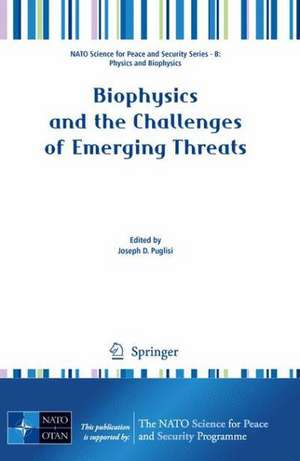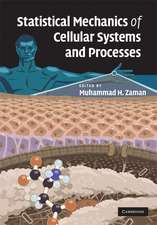Biophysics and the Challenges of Emerging Threats: NATO Science for Peace and Security Series B: Physics and Biophysics
Editat de Joseph Puglisien Limba Engleză Paperback – 5 iun 2009
| Toate formatele și edițiile | Preț | Express |
|---|---|---|
| Paperback (1) | 934.07 lei 6-8 săpt. | |
| SPRINGER NETHERLANDS – 5 iun 2009 | 934.07 lei 6-8 săpt. | |
| Hardback (1) | 945.30 lei 6-8 săpt. | |
| SPRINGER NETHERLANDS – 5 iun 2009 | 945.30 lei 6-8 săpt. |
Din seria NATO Science for Peace and Security Series B: Physics and Biophysics
- 18%
 Preț: 955.25 lei
Preț: 955.25 lei - 18%
 Preț: 1222.62 lei
Preț: 1222.62 lei - 24%
 Preț: 1049.38 lei
Preț: 1049.38 lei - 24%
 Preț: 788.30 lei
Preț: 788.30 lei - 18%
 Preț: 1223.74 lei
Preț: 1223.74 lei - 18%
 Preț: 1830.34 lei
Preț: 1830.34 lei - 15%
 Preț: 643.99 lei
Preț: 643.99 lei - 18%
 Preț: 1212.36 lei
Preț: 1212.36 lei - 18%
 Preț: 947.85 lei
Preț: 947.85 lei - 18%
 Preț: 950.52 lei
Preț: 950.52 lei - 20%
 Preț: 565.64 lei
Preț: 565.64 lei - 18%
 Preț: 950.66 lei
Preț: 950.66 lei - 24%
 Preț: 1060.04 lei
Preț: 1060.04 lei - 5%
 Preț: 1412.06 lei
Preț: 1412.06 lei - 18%
 Preț: 1226.90 lei
Preț: 1226.90 lei - 18%
 Preț: 945.79 lei
Preț: 945.79 lei - 18%
 Preț: 1221.20 lei
Preț: 1221.20 lei - 24%
 Preț: 789.60 lei
Preț: 789.60 lei - 18%
 Preț: 947.67 lei
Preț: 947.67 lei - 24%
 Preț: 1053.39 lei
Preț: 1053.39 lei - 18%
 Preț: 1834.77 lei
Preț: 1834.77 lei - 18%
 Preț: 943.08 lei
Preț: 943.08 lei - 15%
 Preț: 640.06 lei
Preț: 640.06 lei - 18%
 Preț: 945.30 lei
Preț: 945.30 lei - 18%
 Preț: 1217.62 lei
Preț: 1217.62 lei - 18%
 Preț: 951.14 lei
Preț: 951.14 lei - 18%
 Preț: 1216.02 lei
Preț: 1216.02 lei - 18%
 Preț: 1839.17 lei
Preț: 1839.17 lei - 15%
 Preț: 645.47 lei
Preț: 645.47 lei - 18%
 Preț: 1220.57 lei
Preț: 1220.57 lei - 18%
 Preț: 1217.90 lei
Preț: 1217.90 lei - 18%
 Preț: 1228.96 lei
Preț: 1228.96 lei - 18%
 Preț: 1232.71 lei
Preț: 1232.71 lei - 15%
 Preț: 652.17 lei
Preț: 652.17 lei - 18%
 Preț: 1220.88 lei
Preț: 1220.88 lei - 15%
 Preț: 639.73 lei
Preț: 639.73 lei - 18%
 Preț: 1224.36 lei
Preț: 1224.36 lei - 18%
 Preț: 1828.29 lei
Preț: 1828.29 lei
Preț: 934.07 lei
Preț vechi: 1139.10 lei
-18% Nou
Puncte Express: 1401
Preț estimativ în valută:
178.82€ • 184.00$ • 150.73£
178.82€ • 184.00$ • 150.73£
Carte tipărită la comandă
Livrare economică 01-15 martie
Preluare comenzi: 021 569.72.76
Specificații
ISBN-13: 9789048123674
ISBN-10: 9048123674
Pagini: 186
Ilustrații: VII, 179 p.
Dimensiuni: 155 x 235 x 17 mm
Greutate: 0.27 kg
Ediția:2009
Editura: SPRINGER NETHERLANDS
Colecția Springer
Seria NATO Science for Peace and Security Series B: Physics and Biophysics
Locul publicării:Dordrecht, Netherlands
ISBN-10: 9048123674
Pagini: 186
Ilustrații: VII, 179 p.
Dimensiuni: 155 x 235 x 17 mm
Greutate: 0.27 kg
Ediția:2009
Editura: SPRINGER NETHERLANDS
Colecția Springer
Seria NATO Science for Peace and Security Series B: Physics and Biophysics
Locul publicării:Dordrecht, Netherlands
Public țintă
ResearchCuprins
A Simple Model for Protein Folding.- Complementarity of Hydrophobic/Hydrophilic Properties In Protein—Ligand Complexes: A New Tool to Improve Docking Results.- Structures of Cvnh Family Lectins.- Biophysical Approaches To Study Dna Base Flipping.- The Diversity of Nuclear Magnetic Resonance Spectroscopy.- Improved Dye Stability in Single-Molecule Fluorescence Experiments.- The Evaluation of Isotope Editing and Filtering for Protein—Ligand Interaction Elucidation by Nmr.- Ribosome: an Ancient Cellular Nano-Machine for Genetic Code Translation.
Caracteristici
Presents state of the art information on NMR spectroscopy, and its place in the broader field of biophysics No other monograph presents such a wide range of topics, including NMR spectroscopy, protein folding, X-ray crystallography, spectroscopy and applications












